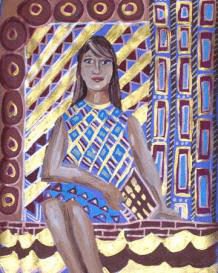Goal (Terminal Objective):
Painting, Design
Objective:
Students will utilize pattern and rendering techniques to create a portrait in the style of Gustav Klimt. Students will gain knowledge of early mosaic work which influenced the decorative portrait style of Gustav Klimt.
National Standards:
Visual Arts Grades K4 Content Standard 1: Understanding and applying media, techniques, and processes
Visual Arts Grades K4 Content Standard 2: Using knowledge of structures and functions
Visual Arts Grades K4 Content Standard 3: Understanding the visual arts in relation to history and cultures
Purpose:
Students will study the work of Gustav Klimt. Students will identify significant trends in cultural and artistic movements influencing the development of his individual style.
New Vocabulary:
rhythmic pattern, portrait, selfportrait, geometric shape, repetition, proportion, Art Nouveau, background, mosaic, decorative
Materials:
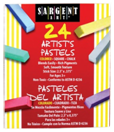
#224124 Sargent Square Chalk Pastels
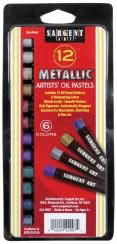
#32-2007 Metallic Oil Pastels
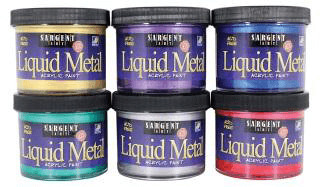
#221206 Liquid Metals Acrylic Paint
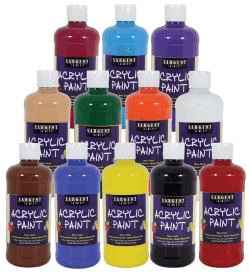
#242499 Sargent Art Acrylic Paint
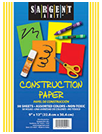
#23-40xx 50 sheets construction paper solid color pack in dark colors

#22-7244 144 ct. Graphic Pencils
Construction paper in dark colors, pencils
Time:
This lesson may be modified from one to five hours, depending upon the size and complexity of expectations.
Introduction and Motivation (Set):
Overview the assignment, provide example. Define and provide examples of portraits and self portraits.
Show and compare examples of Klimt’s work and early Christian mosaics. Discuss how his early visits to Italy and his love of the mosaics seen on his tours influenced his art.
Point out use of pattern in Klimt’s portraits.
Discuss Klimt’s role in the Art Nouveau movement. List the characteristics of the Art Nouveau style.
Display visual references such as examples of Klimt’s paintings as well as fabrics and wallpaper with pattern. Discuss how patterns form both the subject matter and the background of Klimt’s portraits.
Instruction:
View exemplars. Discuss the work of Gustav Klimt with reference to his use of simplified stylized figures merged with patterned backgrounds and other general characteristics of his work.
Identify and discuss what attracts the viewer’s attention in each artwork. Why? Discuss how pattern is used in the artwork.
Demonstrate how to outline and demonstrate techniques for creating mosaic effects in a drawing: repeating patterns, using dots and dashes of intense color; adding sparkle with metallic paint.
Activities:
(1) Guided Practice:
- Students create gesture line sketches using student model. Students will use characteristics from the work of Gustav Klimt focusing on background techniques.
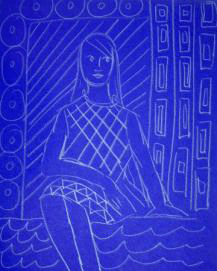
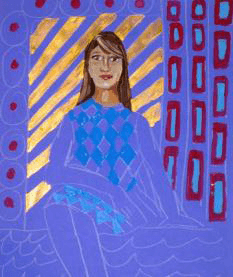
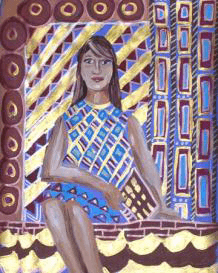
(2) Independent Practice and Check for Understanding: Teacher circulates among working students visually recording students demonstrating understanding of objectives and provides reinforcement.
- Using chalk on an 18” x 24” colored paper create final portrait sketch.
- Check for facial and body proportion.
- Students paint in large areas. Add pattern using oil pastels over the painted areas. Fill in the background with patterns, ornaments, and metallic color using Acrylics or Liquid Metals markers. The same pattern in the figure and background could be used but change the size or color, darkness, or lightness.
- Students use Sargent Fine Tip markers to enhance detail.
(3) Closure: Students record either by checklist or writing prompt, the symbols used, the connection to the styles of either exemplar artist and the innovations they provided to the piece. Sketchbook may be included.
Evaluation:
Teacher/student critique, individual evaluation with a rubric, group critique, selfreflection, teacher assessment. Did student create a Klimtinspired portrait? Did students understand the concept of Klimt’s “painted mosaics?”
Extension:
This strategy may be extended to combine individual student artworks into a collaborative art installation. Discuss why mosaics were important in early Christian Churches. Research. Use contour drawing to create portraits of your family. Fill a page with patterns typical of the Art Nouveau movement.
Resources:
http://en.wikipedia.org/wiki/Gustav_Klimt
http://www.ibiblio.org/wm/paint/auth/klimt/
http://www.artcyclopedia.com/artists/klimt_gustav.html
Art Consultant



